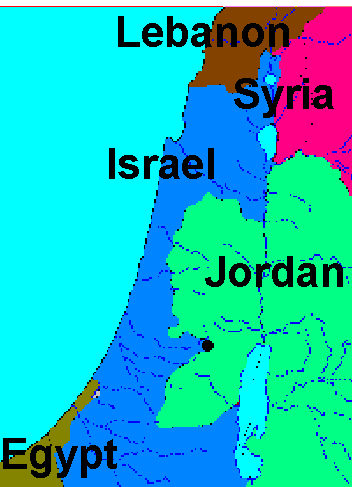|
|
|
establishment of the state of israel
|
|
|
| 1947 | The
United Nations votes to partition of Palestine into two sovereign states -
one Arab, one Jewish. Under this plan Jerusalem would be
internationalized. The transition from British rule would occur on Oct. 1,
1948.
Jews accept the U.N Partition Plan. Arabs, resenting another instance of Western imperialism, reject it. Estimated population: Arabs 1,300,000; Jews 600,000. |
|
|
| Arab | |||
| Jewish | |||
| 1948 | Violence
intensifies. This worries the United States, whose U.N. Ambassador wants
partition delayed to allow U.N. trusteeship to defuse the situation.
Britain rejects a United Nations Commission in Palestine. Hence, there will be no transitional government. The British will simply withdraw. There is a plan is for Trans-Jordan to seize the territory partitioned for the Arab State. March - Ben Gurion, leader of the Jewish population, notifies the U.N. that a provisional Israeli government is being established. May 14 - As the British withdraw and Egyptian planes fly overhead, the State of Israel declares its independence. It announces a "Right of Return" whereby Israel is to be open to all Jews who wish to enter. Israeli citizenship is to be available to all regardless of religion, race, or sex. The United States extends de facto recognition to the new state, others follow. Egypt, Syria, Lebanon, and Iraq prepare to invade both to attack Israel and to prevent Trans-Jordanian expansion. May 15 - Egypt,
Trans-Jordan, Syria, Lebanon, and Iraq invade the new state of Israel, but
the assaults are repulsed. Perhaps 750,000 native Arabs either flee or are
forcibly displaced from their lands within the borders of the new state.
At the same time, about 800,000 Jewish residents flee Iraq, Tunisia,
Syria, Egypt, Libya, Yemen, and other Arab countries. About 500,000 were
immediately went to Israel and became citizens in the new state. |
||
| 1949 | February - Egypt signs an armistice with Israel. In March Lebanon and in April Trans-Jordan sign agreements. Syria does so in July. All these are based on the existing military borders that have resulted from the conflict. |  |
|
| Arab Refugees - Seeds of
Future Strife:
The turmoil accompanying the 1948 war resulted in both the displacement of Jews in Arab countries and of some Arabs in the new nation of Israel. More than half of the displaced Jews became Israeli citizens but lost properties in their native Arab countries. The displaced Arabs assembled in refugee camps in neighboring countries and the West Bank and Gaza Strip. Some Arab towns within Israel became Jewish towns. This creates the question of the circumstances by which displaced Arab refugees could someday return to their properties or receive negotiated compensation. |
|||